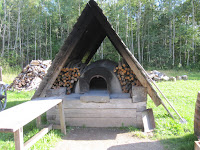When it is in the 30's and wet, one is relegated to activities that have been put off while the weather was nice. Organizing recipes, reading the backlog of books, magazines and newspapers, organizing "things," cooking and in my case, mastering some new intimidating task like knitting mittens and, using the iPad to blog as well as migrating from a PC to a Mac.
When I got the iPad, I looked forward to a compact device for travel that would allow Internet access and blogging while on the road. The Internet access worked whenever the wifi or 3G signal was adequate, which surprisingly was often not the case. Even campgrounds that advertised wifi fell pretty short unless one wanted to sit in the office. After a day of travel that held little appeal, so the blog entries suffered. The biggest blog challenge however came in the area of including recently taken pictures on the blog. It turns out that the various blog platforms don't directly access the pictures on the iPad. So I have been forced to search for picture and blog apps to serve as a bridge. Reading google entries about the issue and talking to Apple techies yielded no simple solution so I am forcing myself to learn more that I ever wanted to (or needed to when I had Lorraine, Gorman and Mark) to deal with those annoying problems. They may not be aware but they are getting their revenge. Add to that the recent decision to migrate to a Mac from years of PC use and I am busy. My stubbornness keeps me from giving up and I tell myself that this will keep some agility in the old brain. If this ever gets posted and has pictures, links etc you will know there is some level of success. Also, after touting the iPad to Jane for blogging I must figure this out before she takes off for the Galapagos in February
TREES AND VIEWS
The first picture attempt will be the before the wizard tree guy Jim who came to restore our view. Here in the NW a view can be obliterated in a season as trees, shrubs and ivy grow with enthusiasm. Winter is the time for such pruning, as the foliage is gone and so much more can be seen. The obscured view is of the Olympic mountains, often snow covered and majestic on a clear day.
Speaking of Jim, he is super cool among the "boys" here on the island. He has the biggest Kubota tractor on the island. While John Deere gets the press, the heavy duty users seem to prefer Kubota. I got to sit on it the other day. It makes Richard's Kubota look like a riding mower (sorry Richard).
I don't really like to watch, particularly when the tree sways. This is Jim's tractor.
 Many trees are now down, providing a northwest view from nearly every room. Too bad it is cloudy today.
Many trees are now down, providing a northwest view from nearly every room. Too bad it is cloudy today.
TECHIE STUFF
My experience at the Apple Store Has been generally great. I make regular use of my $100 year-long one to one sessions. I try to record questions about my Mac, iPad, iPhone as well as Richard's Apple devices and then cover as much as possible in my 50 minutes. We have to take the ferry to Tacoma, a trip of about an hour from door to door. Much prettier and more relaxing than the old work commutes. I love having a live person to work with and I can see I will be more proficient than I ever was with a PC, some day I think the Apple store is one place where both little kids and seniors are working on similar things though one group is a lot more capable I suspect. A class came to visit during one of my sessions.
COMFORT FOOD
The fall and winter are such wonderful times to cook. The fire is going and being inside when it is in the 30's is a must for me. The season starts with chanterelles-
eat your heart out SoCal cooks. While I am busy trying new recipes I seem to cut out more and acquire new cookbooks at a much faster rate. It is nice that Richard is adventurous AND appreciative.

Well, I think this will work. It is not as easy as on the laptop using blogspot directly but it sure is nice to travel with a small device.


























